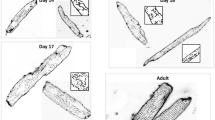Abstract
Neonatal cardiomyocytes of the rat were investigated (a) by Confocal Laser Scanning Microscopy (CLSM) using the Ca2+-sensitive dye fluo-3/AM to measure calcium transients, and (b) by a Laser Doppler Microscope (LSC-1) to obtain data of the cell culture's contractility. Our experiments resulted in: (1) About 20% of the freshly prepared cardiomyocytes exhibited spontaneous but not rhythmically appearing calcium transients. None of these cells was found to be active mechanically. The remainder of 80% showed neither calcium transients nor cell movements. (2) At the latest after four days of cultivation, the cells showed spontaneous calcium transients of constant frequency and concomitant contractions. (3) During the cultivation, spontaneous Ca2+ transients became steeper and shorter. The time course of the calcium transient is abbreviated by a factor of at least two in cells after four days when compared with cardiac cells after one day of cultivation. (4) Addition of 100 nM ryanodine caused an increase of the cytosolic calcium concentration and a decrease of the amplitude of the Ca2+ transients. This effect became more significant with increasing time of cultivation and ran parallel to a decrease of the cell's contractility. (5) Addition of 1 μM thapsigargin yielded a similar increase of the cytosolic calcium concentration and a decrease of the Ca2+ peak accompanied by a smaller lowering of the contractility (in comparison with the mentioned influence of ryanodine). The effects of thapsigargin were practically independent of the time of cultivation.
Similar content being viewed by others
References
Wibo M, Bravo G, Godfraind T: Postnatal maturation of excitationcontraction coupling in rat ventricle in relation to the subcellular localization and surface density of 1,4-dihydropyridine and ryanodine receptors. Circ Res 68: 662–673, 1991
Fisher D, Tate C, Phillips S: Developmental regulation of the sarcoplasmic reticulum calcium pump in the rabbit heart. Pediatr Res 31: 474–479, 1992
Lubic S, Giacomini K, Giacomini J: Increase of 1,4-dihydropyridine binding sites in serum-stimulated cardiomyocyte hypertrophy. J Pharmacol Exp Ther 270: 697–701, 1994
Nakamura N, Asai J, Hama K: The transverse tubular system of rat myocardium: its morphology and morphometry in the developing and adult animal. Anat Embryol 173: 307–315, 1986
Gomez JP, Potreau D, Branka JE, Raymond G: Developmental changes in Cat' currents from newborn rat cardiomyocytes in primary culture. Pflügers Arch 428: 241–249, 1994
Wetzel G, Chen F, Klitzner T: L- and T-type calcium channels in acutely isolated neonatal and adult cardiac myocytes. Pediatric Res 72: 89–94, 1991
Wetzel G, Chen F, Klitzner T: Ca2+ channel kinetics in acutely isolated fetal, neonatal, and adult rabbit cardiac myocytes. Circ Res 72: 1065–1074, 1993
Huynh T, Chen F, Wetzel G, Friedman W, Klitzner T: Developmental changes in membrane Ca2+ and K+ currents in fetal, neonatal, and adult rabbit ventricular myocytes. Circ Res 70: 508–515, 1992
Gomez J P, Potreau D, Raymond G: Intracellular calcium transients from newborn rat cardiomyocytes in primary culture. Cell Calcium 15: 265–275,1994
Wallukat G, Wollenberger A: Supersensitivity to β-adrenoceptor stimulation evoked in cultured neonatal rat heart myocytes by L(+)lactate and pyruvate. J Auton Pharmacol 13: 114, 1993
Husse B: Ca2+-Transienten and Kontraktilität von Herzzellkulturen neonataler Ratten-Beeinflussung der Ca2+- Homoöstase durch Pharmaka and Treibintervallanderungen. Dissertation, MathNat-Techn Fak, Martin-Luther-Universität Halle-Wittenberg, 1995
Maylie J: Excitation-contraction coupling in neonatal and adult myocardium. Am J Physiol 242: H834-H843,1982
Seguchi M, Harding J, Jarmakani J: Developmental changes in the function of sarcoplasmic reticulum. J Mol Cell Cardiol 18: 189–195, 1986
Klitzner T, Friedman W: A diminished role for the sarcoplasmic reticulum in newborn myocardial contraction: effect of ryanodine. Pediatr Res 26:98–101,1989
Tanaka H, Shigenobu K: Effect of ryanodine on neonatal and adult rat heart: Developmental increase in sarcoplasmic reticulum function. J Mol Cell Cardiol 21: 1305–1313,1989
Chien T, Friedman W, Klitzner T: Developmental changes in cardiac myocyte's calcium regulation. Cite Res 67: 574–579,1990
Thastrup O, Dawson A, Scharff O, Foder B, Cullen P, Drobak B, Bierrum P, Christensen S, Hanley M: Thapsigargin, a novel molecular probe for study in intracellular Ca2+ release and storage. Agents and Actions 27: 17–23,1989
Inesi G, Sagara Y: Thapsigargin, a high affinity and global inhibitor of intracellular Ca2+ transport ATPases. Arch Biochem Biophys 298: 313–317,1992
Kirby M, Sargara Y, Gaa S, Inesi G, Lederer W, Rogers T: Thapsigargin inhibits contraction and Ca2+ transient in cardiac cells by specific inhibition of the sarcoplasmic reticulum Ca2+ pump. J Biol Chem 267: 12545–12551, 1992
Wrzosek A, Schneider H, Grueninger S, Chiesi M: Effect of Thapsigargin on cardiac muscle cells. Cell Calcium 13: 281–292, 1992
Chiesi M, Wrzosek A, Grueninger S: The role of the sarcoplasmic reticulum in various types of cardiomyocytes. Mol Cell Biochem 130: 159–171, 1994
Author information
Authors and Affiliations
Rights and permissions
About this article
Cite this article
Husse, B., Wussling, M. Developmental changes of calcium transients and contractility during the cultivation of rat neonatal cardiomyocytes. Mol Cell Biochem 163, 13–21 (1996). https://doi.org/10.1007/BF00408636
Issue Date:
DOI: https://doi.org/10.1007/BF00408636




